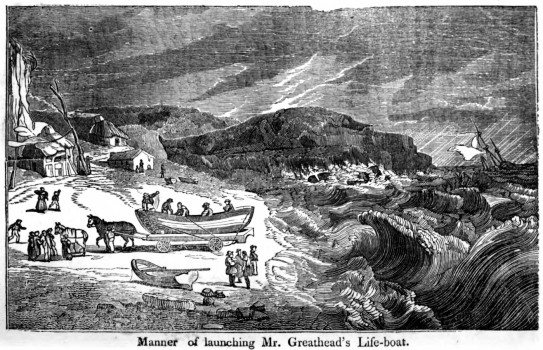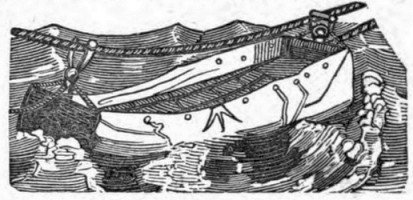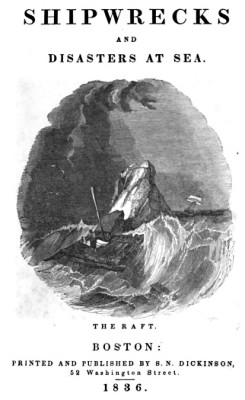Page 416
Page 417
LIFE BOATS, LIFE PRESERVERS,
AND Expedients
for the Preservation of Mariners.
Though man be a helpless and perishable creature when
removed from the element appropriated for his existence,
he is not altogether unprovided by nature with powers for
contributing towards his own safety.
Strong, nervous, and
resolute, he may long contend with danger; and notwithstanding
the preponderance of untoward circumstances
may often effect his destruction, he is placed in many situations
where exertions may be successfully used for self-preservation.
In the first place, every one
liable to the casualties of
the sea, ought to acquire the art of swimming.
This is
not difficult of attainment, and among the South Sea
Islanders, water is an element as familiar as the air.
The
human body is in itself, somewhat lighter than the same
bulk of water; and we can float conveniently for a considerable
length of time, if we are possessed of sufficient
self-confidence, and some art in balancing the body.
Not
always long enough, it must be admitted, for complete protection
against the disasters which happen on the ocean, or
even on rivers or canals, on
all of which such multitudes
are scattered by the industrious and adventurous spirit of
the age.
Nor, in cases of shipwreck,
does the casual additional
support of a mast, an oar, or a plank, always suffice to
lend that buoyancy, on account of this unsteadiness, which
the perils of the deep often demand.
More fixed appendages, of various
descriptions, have at different periods
been introduced to the notice of the public, under the appellation
of life preservers; and boats upon a similar principle
under the name of life boats, have been constructed,
so as to be secured against, even when filled with water,
and in the most tempestuous weather for the purpose of
rescuing from destruction those who are ready to perish.
Page 418
The most simple Life Preserver,
is a small square open
wooden frame, used by the Chinese, and other oriental
nations, and so common that few vessels venture to sea
without several of them.
Fig. 9
The frame is
formed of four pieces of bamboo with projecting ends, united
together by cords or jointers into a hollow square, which
is drawn up from the feet to below the arms.
There it remains secure from its own buoyancy
pressing upwards, and it supports the head and shoulders
above water.
Another simple expedient is the
cork jacket.
Its structure is of great simplicity, consisting merely of a canvass jacket
with a number of pieces of cork sewed
within or fastened to it.
The buoyancy of
these supports the human body floating on the waves,
while their thickness affords a defence against the rocks
whereon a turbulent sea may dash the sufferer.But the buoyancy of cork has given way to
the superior buoyancy of air, and jackets distended with
this very light fluid, or
attached vessels of other
forms filled with it have been occasionally adopted. The simplicity and convenience of the life preserver invented by Schoffer must at once be perceived.
It consists of a hollow
cylinder, formed without a seam, and perfectly air tight,
bent when distended with air and ready for use, as in
figure 2; or it is what may
be termed a cylindrical ring, also without the break which
appears in the former, represented in figure 1;
|
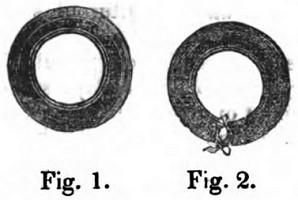 |
Page 419
of this ring the external
diameter is generally about 92
inches, the internal diameter about 12, and the diameter of
the part containing the air about 5 1/2, the dimensions
varying of course, by being specially adapted to the size of
the person by whom it is designed to be employed.
By
its form, it is well fitted for the place which it occupies,
being situated beneath the arms; it does not press painfully
upon the chest, and the suspension or support being
placed so high, enables the lower part of the body and
extremities, to act as a pendulum, in keeping the wearer
vertical or restoring him to that position, if thrown aside
by the force of the waves.
The two holes are in one ring, the
only openings, and receive a stop-cock to which an ivory
pipe is fixed.
Through this pipe the air is injected by the
mouth, and retained by the stop cock, the adjustment and
inflation only occupying the short space of one minute:
when unexpanded, it folds up into a very small compass,
so as to be conveyed in the pocket: and is also very portable,
its weight being about a pound.
They are made
of cloth and leather made air tight, but india rubber is the
best article to make them of.
Mattresses filled with cork
shavings have been recommended as a necessary precaution
in cases of shipwreck, as they can be strapped on to
persons.
Less attention, however, seems
to have been excited by
these and analogous expedients, than to the construction of
vessels, which should either be capable of resisting the
effects of a stormy sea, or adapted to bring the crew of a
stranded vessel to a level shore.
Even the rudest savages
have constructed boats better calculated for the safety ;of
mariners than those which are by far the most part, employed
by civilized nations acquainted with all the mechanical
arts.
The canoes of the South Sea
islanders, for example, are
provided with wooden frames, by us called out-riggers,
extending from each side between the prow and the stern,
which preserve their equilibrium in the sea.
Though these
vessels, being long and narrow, are incapable of resisting
the sudden influence of the wind, and would heel to art
alarming degree, the dipping of
the out-rigger counterbalances
the pressure, and restores the canoe to its proper
position.
Boats of a construction widely different, that
Page 420
equally adapted for
preservation, are used by the savage
inhabitants of the northern regions.
The Greenlanders,
with ribs of whalebone, form a kind of frame, which is
covered with the skins of animals stitched together with
sinews, instead of planks, for
a boat.
A deck is made
also of skins, wherein there is a single round hole to admit
the body of the savage occupying it.
The hole is carefully
stuffed, or the edges drawn up around him, and here he
gits with a paddle to guide his course, while his slight embarkation
excludes the water, and from the buoyancy of
its materials, is securely borne over the loftiest wave.
The real origin of the life boat is probably unknown.
It is extremely probable that
the earlier navigators were
not unacquainted with boats somewhat resembling certain
parts of the structure of those which are now most approved.
The curved keel, the application of cork, or confined
air, and boats fashioned so as to row either way, are
not entirely new inventions; and the construction of a
boat peculiarly adapted to keep the sea has been longer a
desideratum than is generally supposed.
A life boat invented by Mr. Greathead, has
obtained great and deserved
celebrity.
Its invention originated from a deplorable catastrophe
which happened near Tynemouth, England, in
1789.
A vessel struck on the Herd Sands during a storm,
when owing to the imminent danger, it proved impossible
to relieve them from the shore; and the unfortunate crew
dropped one after another into the sea, in sight of numerous
spectators.
Deeply affected by their fate, the principal
inhabitants offered a premium for the invention of a
life boat.
Mr. Henry Greathead, had remarked that if a
spheroid be divided into quarters these will float on the
curvature; that they cannot be overset or sunk, and will
be safely borne over broken water.
He thence conceived
that a boat, of a figure somewhat analogous, would possess
the same properties, and be profitably employed in the deliverance
of the shipwrecked persons.
The first attempt
to render it serviceable was successful in 1790.
And it has
since contributed to the preservation of thousands of valuable
lives.
Though more generally
recommended to be thirty feet
long, ten broad, and three feet four inches deep in the
Page 421
centre, the size must be
considered arbitrary, and unquestionably
it is not that on which its properties depend.
The
keel is a curving beam of great convexity downwards; fore
and aft the boat is flat below, and the stem and stern rake
towards each other.
It is probably on this figure, that any
properties possessed by the boats depends, and from the
complete buoyancy obtained by the sides being cased with
seven hundred pounds of cork, four inches thick, proceeding
sixteen inches down from the gunwale. The oars are
short, and adapted in an iron thole, with a grammet, which
enables the rowers, on facing round to row either way ; and
steering is accomplished by an oar at each end.
The
peculiar figure of this boat is conceived to be well adapted
for a stormy sea; the cork on the sides affords perfect
security against its being immerged, and also proves a
mutual defence on approaching the vessel which is to be
relieved, or in landing the crew on a rocky shore.
A
clergyman of the Orkney Islands, named Bremner, proposed
a method of fitting up any boat so as to be a preservative
in time of danger.
This plan is extremely simple.
One common empty cask is to be
secured by lashings with-
in the bow of the boat, and others within the stern in the
same manner, besides which, vacant spaces close to their
place are to be filled up with bags or bundles of cork.
A
horizontal bar of iron or lead is also to be attached to the
keel within the boat.
If a boat be purposely prepared,
ring-bolts are to be fixed to the keel, through which the
ropes are passed within, and through augur holes bored in
the keel without; and if the casks be purposely prepared
likewise, they have slings with two eyes on each end, the
great object being to retain them exactly in their places.
But if there are no ring-bolts,
the inventor of this method
advises that holes be immediately bored in the sides, or the
bottom of the boat to pass
through the ropes securing the
casks, because no danger will be produced, as the buoyancy
immediately begins to be
exhibited on the water reaching
the casks.
The boat is always supposed to be full of
water, and to float by means of the united levity of the
casks and cork contained in it; therefore, though people
sitting in midships, be in the water, they will not increase
the weight, or sink her deeper, but the reverse. One great
Page 422
recommendation of this plan, is
the facility with which it
may be adopted; for there are scarce any ships unprovided
with empty casks, and means may always be found to
secure them in the boat, when extreme necessity shall induce
the crew thus to trust themselves to the waves.
We have given an engraving of a
boat fitted up for a life
boat on the principle invented by Mr. Bray by means of
air boxes secured, under the thwarts.
Its simplicity is
conspicuous in the circumstance of its being applicable to
all boats without the introduction of any incumbrance or
inconvenient fitting up, and its extensive utility appears
to
be sufficiently evident from its being applicable to all
boats
of whatever form or dimensions; and by its affording the
opportunity of bringing into operation, without any attendant
inconvenience, a very great body of confined air, the
superior buoyancy of which is well known, one cubic foot
of air being capable of supporting 50 lbs.
Capt. G. TV. Manly, invented
the following plan for
the preservation of shipwrecked seamen, which has been
attended with signal success on the coast of Great Britain,
where it has been adopted.
Instructions.
After the means
of communication have been effected between a stranded
vessel and the shore. by a rope attached to a shot projected
from a mortar, it is often found a matter of great
difficulty
to make the persons on board understand how they are to
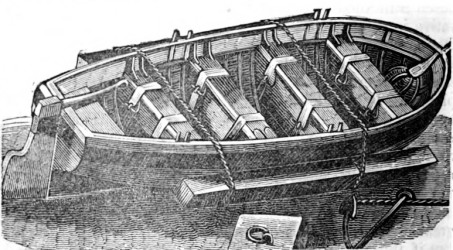
Mr. Burn's Life Boat.
Page 423
act, and many lives have been
lost through this cause
alone.
In order to remedy this evil, and to render this
system of relief mutually and immediately understood, the
following instructions are submitted :—
Directions to persons on board
Vessels stranded on a Lee-Shore.
It is your duty, as well, no doubt, as your inclination,
to use every honorable and manly endeavor to save the
vessel and cargo committed to your care, and to satisfy
yourself that these have failed before it is a justifiable
resource to run the ship on shore, for the preservation of
your own lives.
On the determination being made to run
for the beach, every exertion should be made to keep your
vessel off the shore till high water, and then if canvass
is or can be set, steer your vessel stem on, with as much
force as possible, making signals of distress to attract the
notice of the people on shore, who will collect at the point
most favorable for the purpose, and prepare to assist you;
endeavor to run for the spot where they are collected.
Shipmasters, on these occasions
must enforce their authority
more than ever, and seamen must be more than usually
obedient, as the safety of all on board will frequently depend
on this.
Whether a vessel is thus run on shore, or is
stranded, without any chance of time or place, the following
directions will equally apply, and must be minutely
observed and practised :-
Collect in some safe part of the
vessel, ready to apply as occasion may require, all your
small lines and ropes, buoys, pieces of cork, or small kegs,
(such as seamen keep spirits in,) snatch, tail, and other
blocks, with a warp or hawser clear, axes, knives, &c.;
all
these may be of great use.
Attend to the people on shore,
and observe if they have a boat, or are getting one to the
Page 424
spot, as their first object
would be to launch it to you, and
to throw a line on board to you, to haul her off with; in
that case they will make signal No. 1.
The signals, illustrated by
representations and their distinct meanings, will be
hereafter described.
On receiving the line, you will secure
the end to such part of the vessel as may best draw the
boat into a safe lee.
If the people on shore, after you have
received the line, make signal No. 2, you will bend the
warp or hawser to the line, and they will draw it on shore,
fearing to trust the boat to the small line.
When the bend
is made, and you are ready, make your signal No. 1. (which
will be hereafter described, expressing yes.)
If, when you have got the line, the people on shore find you
have not a warp ready, and wish you to haul on board by it
a stouter
rope to haul the boat off
with, they will make signal No. 3, to haul away, for you to
receive a stout rope; secure it as before directed, and make
your signal number one, which is also to denote you are
ready, or their direction is complied with.
Remark.
A boat, when it can be applied, is the promptest
method of bringing a crew on shore.
Upwards of
twenty crews have been saved by them.
If, when you have received the
line, and observe there is
no boat at hand, and the signal on shore (No. 3) is made,
you will haul in, and receive by it the end of a stout rope,
and a tail-block rove with a small line, both ends of which
are kept on shore; make the stout rope and the tail of the
block well fast round your mast, higher or lower, as circumstances
may require, and the tail-block close below the large
rope.
On your making signal No. 1, denoting to have
complied with the directions of having carefully secured
the stout rope and tail-block, the people on shore will haul
taut the stout rope, and place on it a snatch-block, (with
a sling hanging to it large enough to hold a man;) and
making the ends of the small line fast to the lower part. of
the snatch-block, they will
work it to the ship, when
on a man getting into the
sling, he will, by pulling
down the slide or button, secure himself by the waist to
the upper part of the sling, prevent the possibility of
falling
Page 425
out; and on seeing the clasp*
of the block forelocked,
make signal No. 1, that
all is ready, the people
on shore will haul the
man to the land, and in
the same manner will
travel the snatch-block
back, until every person
is got from the wreck, as
here represented.
Remark.
Crews have thus been brought in safety
from distances exceeding 240 yards from the shore, and
also from wrecks to the top of a cliff.
If the vessel stranded
have women, children, sick or infirm
persons on board, who could
not go aloft, instead of a
snatch-block and sling, a cot, with
lashings, to prevent persons being washed out maybe worked in
the manner just described.
|
 |
If the stranded vessel is
driven among the rocks, and the
persons in danger of being killed, or severely wounded
from the surf dashing them with force against the rocky
beach, a hammock, stuffed
with cork parings or
shavings, as here represented, would
protect
them from injury.
If the people on shore have
only the means of projecting
a line for your preservation, they will make signal No 4,
for
you to secure it, and draw on board so much as will fully
reach from the vessel to the shore, to ensure a continued
communication; with it make a clove hitch, which
is to be put over the shoulders and arms of those to be
brought on shore, and draw it tight in the manner here
• This remark is necessary,
from the omission of the clasp being here
represented, that should cross the mouth of the block.


